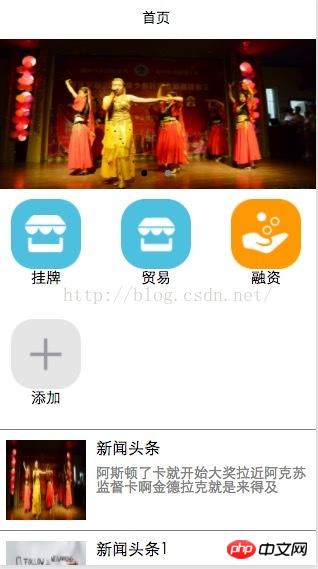Home >WeChat Applet >Mini Program Development >Detailed explanation of WeChat applet page jump and parameter passing
Detailed explanation of WeChat applet page jump and parameter passing
- 巴扎黑Original
- 2017-04-01 15:56:102496browse
This article mainly introduces the relevant information on the detailed explanation of page jump of WeChat mini program, and attaches simple examples and implementation renderings. Friends in need can refer to
WeChat mini program page jump Passing parameters is a function that must be used when making WeChat mini programs. Here I will record the information I learned to implement the code.
I have just come into contact with WeChat mini-programs, and I don’t know much about the syntax and attributes in them. If there are not many places, I hope you can give me some advice. Today I will talk about how to jump and transfer parameters in the WeChat applet. Without further ado, let’s get straight to the code.
The function implemented is to add a click function to the list and pass parameters to the next page;

The code is as follows:
<import src="../WXtemplate/headerTemplate.wxml"/>
<view>
<!--滚动图-->
<view>
<swiper indicator-dots="{{indicatorDots}}" autoplay="{{autoPlay}}" interval="{{intervalTime}}" duration="{{Time}}">
<block wx:for="{{imageURl}}">
<swiper-item>
<image src="{{item}}" class="imagePX"></image>
</swiper-item>
</block>
</swiper>
</view>
<!--功能按钮-->
<view class="section-bg">
<block wx:for="{{buttonNum}}">
<!--模版-->
<template is="buttonList" data="{{item}}"/>
<!--<view class="section-item">
<image class="section-img" src="{{item.image}}"></image>
<text class="section-text">{{item.text}}</text>
</view>-->
</block>
</view>
<!--资讯列表-->
<view>
<block wx:for="{{listNum}}">
<template is="newList" data="{{item,index}}"/>
</block>
</view>
</view>where
4d49e5dbce84bf7a2869c84b59c185f6
The template code is as follows
<template name="buttonList">
<view class="section-item">
<image class="section-img" src="{{item.image}}" bindtap="buttonClick"></image>
<text class="section-text">{{item.text}}</text>
</view>
</template>
<!--list-->
<template name="newList">
<view class="section-list" bindtap="listClick" id="{{index}}">
<view>
<image class="list-img" src="{{item.image}}"></image>
</view>
<view class="section-textt">
<view class="title"><text>{{item.title}}</text></view>
<view class="subTitle"><text>{{item.subTitle}}</text></view>
</view>
</view>
</template>Only the click method is added for the following list
Click list js code
##
listClick:function(event){
console.log(event);
var p = event.currentTarget.id
wx.navigateTo({url:'/pages/xiangqing/xiangqing?id=上一页的参数'})
}wherewx.navigateTo({url:'/pages/xiangqing /xiangqing?id=parameter of the previous page'})
listClick:function(event){
console.log(event);
var p = event.currentTarget.id
wx.navigateTo({url:'/pages/xiangqing/xiangqing?id='+p})
}where p is the id value set above for each row data:{
// text:"这是一个页面"
title:''
},
onLoad:function(options){
// 页面初始化 options为页面跳转所带来的参数
this.setData({
title:options.id
})Then display the code on the page as follows: 89c662c6f8b87e82add978948dc499d2{{title}}de5f4c1163741e920c998275338d29b2

The above is the detailed content of Detailed explanation of WeChat applet page jump and parameter passing. For more information, please follow other related articles on the PHP Chinese website!
Related articles
See more- WeChat Mini Program Simple DEMO layout, logic, and style exercises
- Detailed explanation and examples of WeChat applet wx.request (interface calling method)
- WeChat Mini Program - Detailed explanation of WeChat login, WeChat payment, and template messages
- WeChat applet (application account) simple example application and detailed explanation of the example
- Detailed explanation of WeChat applet for loop

